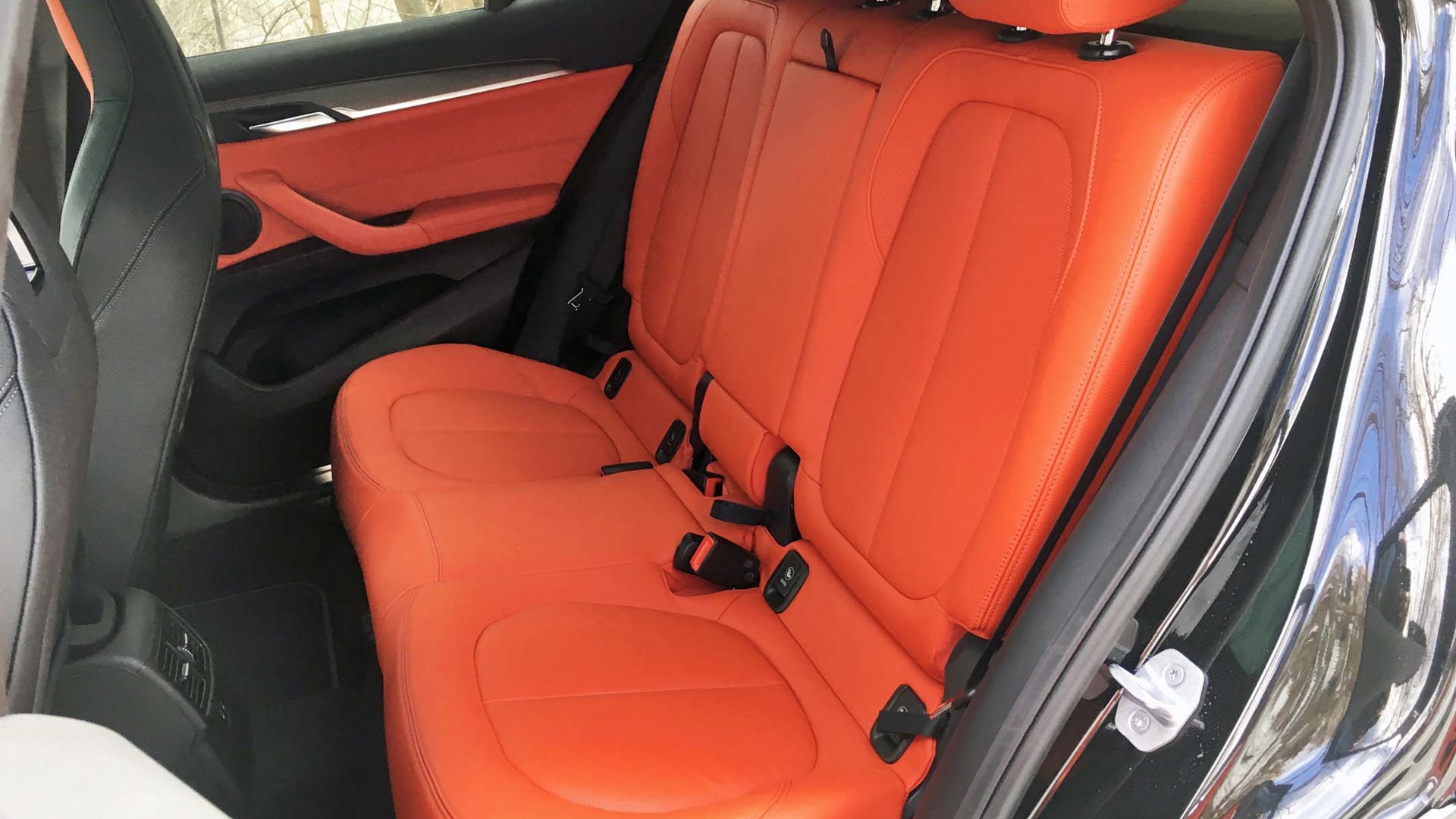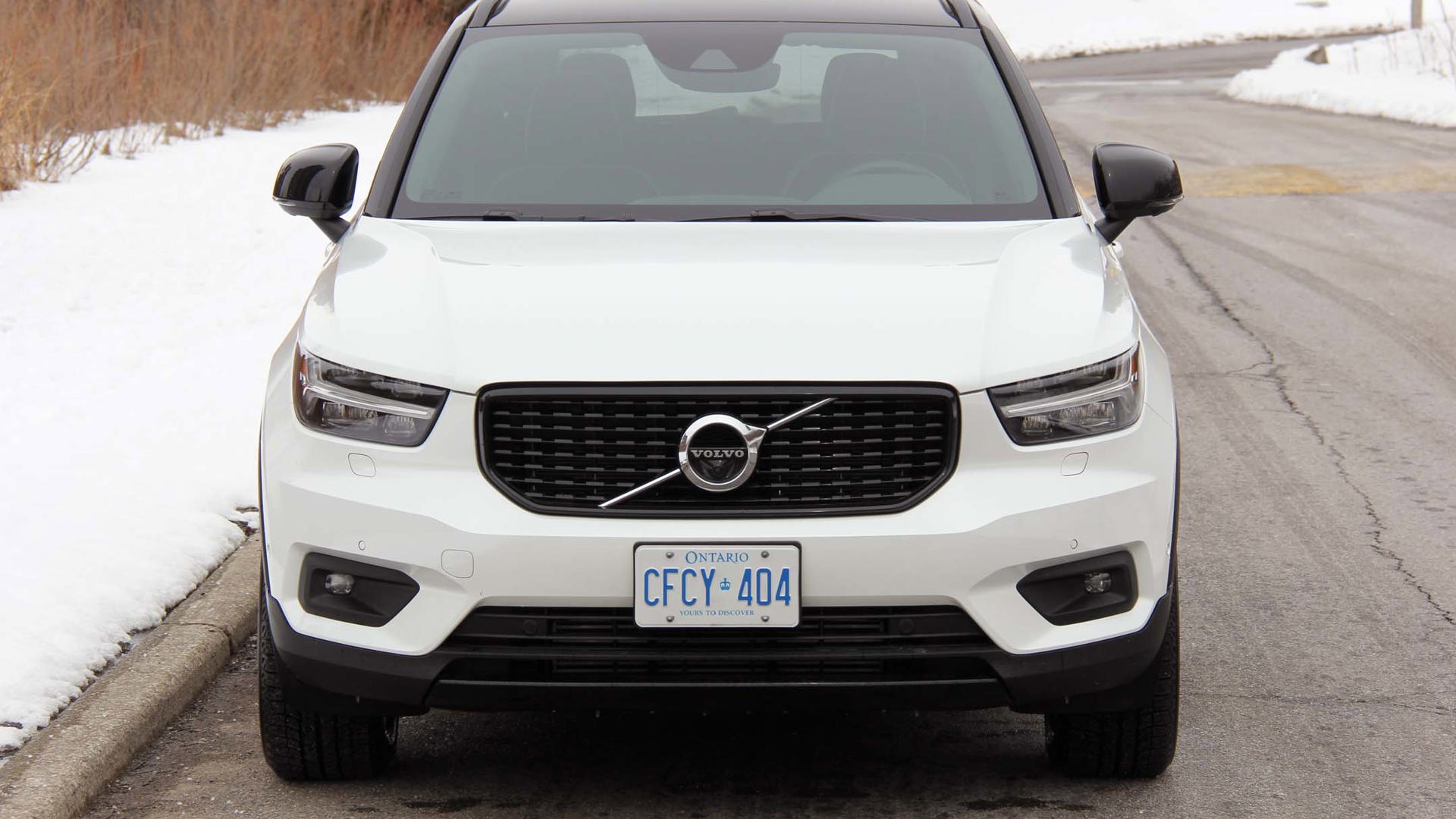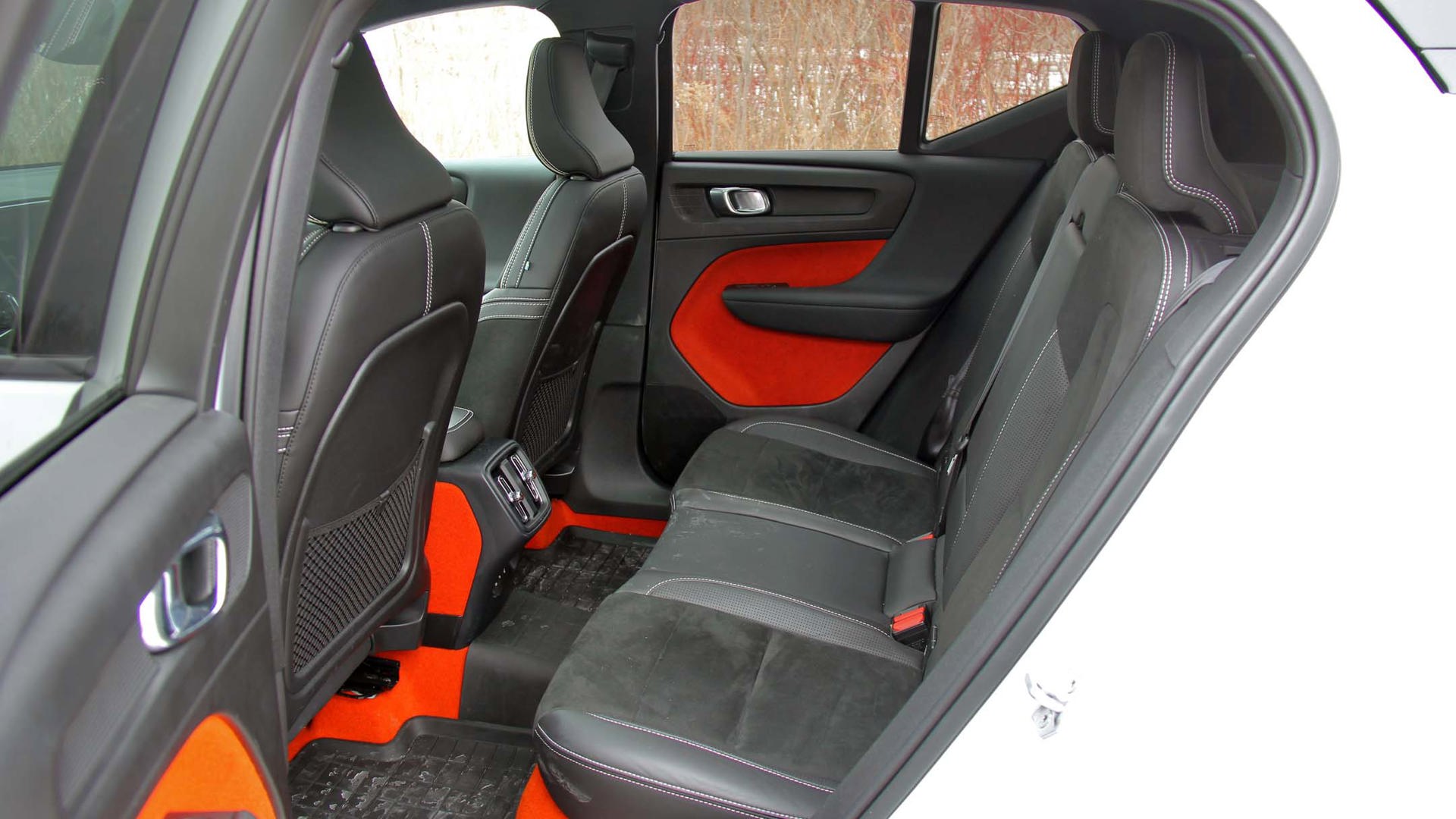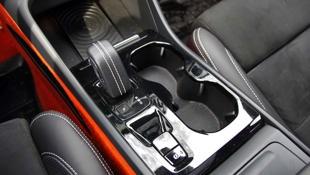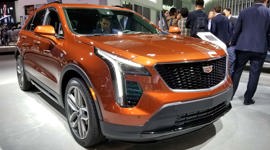Comparison Data
|
2019 BMW X2 M35i
|
2019 Cadillac XT4 Sport
|
2019 Volvo XC40 R-Design
|
|---|---|---|
|
Engine Displacement
2.0L
|
2.0L
|
2.0L
|
|
Engine Cylinders
I4
|
I4
|
I4
|
|
Peak Horsepower
302 hp @ 5,000–6,250 rpm
|
235 hp @ 5,500 rpm
|
248 hp @ 5,500 rpm
|
|
Peak Torque
332 lb-ft @ 1,750 rpm
|
258 lb-ft @ 1,500–4,000 rpm
|
258 lb-ft @ 1,800–4,800 rpm
|
|
Fuel Economy
10.2/8.1/9.4 L/100 km cty/hwy/cmb
|
10.9/8.2/9.7 L/100 km cty/hwy/cmb
|
10.3/7.5/9.0 L/100 km cty/hwy/cmb
|
|
Cargo Space
470 / 1,355 L seats down
|
631 / 1,385 L seats down
|
586 / 1,337 L seats down
|
|
Base Price
$49,200
|
$42,795
|
$44,100
|
|
A/C Tax
$100
|
$100
|
$100
|
|
Destination Fee
$2,245
|
$2,100
|
$2,015
|
|
Price as Tested
$58,995
|
$61,305
|
$54,790
|
|
Optional Equipment
$7,450 – Premium Package Enhanced $5,650; 20" M Alloy Wheels $500; M Sport Seats $950; Wireless Charging w/ Extended Bluetooth and Wi-Fi Hotspot $350
|
$16,310 – Comfort & Convenience Package $2,795; Cadillac CUE w/ Navigation & Bose $1,895; Dual-panel Sunroof $1,795; Enhanced Visibility Package $1,795; Technology Package $1,595; Active Sport Suspension $1,395; 20" Alloy Wheels $1,295; Driver Assist Package $1,295; Twilight Blue Metallic Paint $900; Driver Awareness Package $895; Trailering Package $655
|
$8,575 – Vision Package $1,800; Climate Package $1,250; Convenience Package $1,600; Metallic Paint $900; Lava Orange Carpet & Trim $100; Sensus Navigation $1,000; 20" Matte Black Wheel $975; Harmon Kardon Audio $950
|
Story by Michael Bettencourt, Peter Bleakney, Steven Bochenek, and Dustin Woods
Photography by Michael Bettencourt, Steven Bochenek, and Dustin Woods
Introduction
Michael Bettencourt
Gathering a group of media folks and experienced testers to poke and prod new-to-market rivals often has its logistical obstacles, especially in Canada. But it’s always worth it, because driving competing vehicles back-to-back, over the same roads and conditions, always brings the personality and strengths (and weaknesses) of each vehicle into clear focus, especially when there’s maybe only a bathroom break between hopping from one into its direct competitor.
There are logistical battles, and then there is a full-on MMA-worthy throwdown with Mother Nature. Which is basically what happened when our test day fell at the same time as a record snowfall in late February. Driving loops were taking double or triple the time originally planned, photography and video filming were being hampered by limited visibility courtesy of both falling and blowing snow. Driving impressions were curtailed by slow traffic and sloppy road conditions.
Testing these luxury all-wheel-drive crossovers in true Canadian fashion did come with benefits, as we now know how they can deal with these kinds of weather conditions. Thankfully our test subjects came with greater ground clearance and toasty warm steering wheels. Even their compact size helped them sneak between stuck or buried vehicles, of which there were many. Their all-wheel drive systems allowed us to manoeuvre through unplowed streets and parking lots for group photos that wouldn’t be possible had we been behind the wheel of regular cars.
Unfortunately, one member of the group didn’t come equipped with winter tires – the Cadillac XT4 – as it had not been pulled from GM’s normal winter-tire-equipped press fleet, but had been secured specifically for this autoTRADER.ca group test from another department. As the newest entrant to market in our group, we were happy to have it. However, it was still a touch too early to secure the Lexus UX and Audi Q3, which are slated to hit the Canadian market in spring and early summer, respectively.
Likewise, we asked the Mercedes-Benz GLA to come out to play as well, but it wasn’t available the week of our assembled test. And the entry-luxury GLA was a closer rival to these CUVs than the larger Benz GLC or recently dropped B-Class hatchback.
Thanks to some flexibility amongst our testers and vid crew, a plan was quickly adopted to gather again the following (clear) day to shoot and drive the vehicles once more. This allowed the all-season tire-equipped Cadillac to show notably better than it had the day before in winter whiteout conditions, and though it finished in third place here, it was not its tires that put it there.
Our rankings below go into all the details into where and why each of our high-tech and high-style rivals placed where they did. But no matter how many more multi-vehicle comparison tests we do, it seems a safe bet that it will be a while before a) our comparison day lands in such snowy conditions again, and b) the majority of our contestants show up with orange-dominated interiors. A very safe bet.
Third Place: 2019 Cadillac XT4 Sport
Peter Bleakney
With the 2019 XT4, Cadillac has fleshed out its SUV lineup by jumping headlong into the fiercely competitive premium compact crossover fray. And yes, you could say Caddy is more than fashionably late to this party, as this segment was arguably established by the BMW X3 back in 2003.
Coming third in this contest is no slight, however, as the XT4 is a solid choice in its own right, showing the most passenger room, cargo space, and edging the Volvo XC40 in both ride comfort and NVH (noise, vibration, harshness) suppression. As fellow tester and musician Steven Bochenek noted, “Excellent NVH rating, given how easy it was to talk with a jumbo lifting off overhead at the airport.” In other words, the XT4 is quite Cadillac-ish.
The XT4 rides on fresh Cadillac-exclusive architecture and is powered by an all-new Caddy 2.0L turbocharged four-cylinder. All engineered in North America. In other words, we’re not looking at a warmed over, re-badged GM crossover from here or overseas.
It’s a sharp-looking rig, carrying all the current Cadillac sculpted styling cues – a knife-edge swath of vertical LED running lights, vertical taillights, sharply creased bodywork, and bold grille. The Sport treatment bestows gloss black finish on the grille, window surrounds, and roof rails. We especially appreciated the optional 20-inch split seven-spoke alloys on this tester.
“I liked the styling inside and out, just not as much as the others,” Steve B said. “It’s striking and distinctively Caddy, but newish-looking.”
Compared to the others in this contest, the Caddy’s cabin is quite plain – no real wow factor here – but it is built to a high standard, and this all-new architecture and component set for Cadillac is coming not a moment too soon. Gone are the chintzy chrome accents, impossible haptic “buttons”, and confusing CUE (Cadillac User Experience) of yore.
We now see two tidy rows of well-marked buttons for audio and HVAC below the 8-inch touchscreen, with proximity sensor. And praise be, a volume knob on the centre console. An iDrive-like rotary controller enables navigating the system without prodding the screen. Standard are Apple CarPlay, Android Auto, and LTE Wi-Fi hotspot.
This clean-sheet turbo 2.0L turbo four is a peach – quiet, silky smooth, and devoid of turbo lag. The nine-speed auto works in a similarly unobtrusive manner, although there’s no real sport to be found here. Even in Sport mode, the transmission shifts in a relaxed fashion, and you won’t find any joy in using the paddles. The XT4 is pretty much a total yin to the BMW X2 M35i’s fast, rorty, and sporty yang.
As a functional, day-to-day luxury conveyance, the XT4 excels. You sit up high, here in plush ivory leather chairs, with a commanding view down the road. Fitted to this tester is the $1,395 Active Sport Suspension with continuous damping control. It uses electronic sensors to monitor the road in real time and make damping adjustments every two milliseconds.
Our first day of testing coincided with what could be categorized as a major snowstorm. I wish I could say the Caddy went through this weather like Christmas tinsel though a poodle, but unlike the Volvo and BMW, the XT4 was saddled with all-season tires. Subsequent dry-road testing showed the Caddy’s handling to be competent with good steering feel, and as would be expected of this brand, the XT4 makes for a serene highway cruiser.
With 237 horsepower and 258 lb-ft of torque from 1,400–4,000 rpm, this is the least powerful engine here, yet it never felt overworked. Once the gearbox drops into ninth gear, the four-pot is spinning barely above idle.
The new platform has the wheels pushed out to its extremities, allowing for generous rear seat room, and the long rear door made for the easiest ingress and egress here. Rear-seat comfort is good too, although the seat backs don’t recline like in the BMW.
Despite having an electric water pump for active thermal management, Active Fuel Management (cylinder deactivation), auto-stop/start and an AWD system that will decouple entirely from the rear wheels, the Cadillac was the thirstiest on our group. It was also the heaviest. And the priciest.
This XT4 Sport model starts at $42,795, but a wallop of options – including the aforementioned adaptive damping – pushed the as-tested price to $61,305 (after destination charge and A/C tax).
Second Place: 2019 BMW X2 M35i
Dustin A. Woods
While the three vehicles we tested all share the same basic concept of sporty-minded luxury crossovers, they really couldn’t be more different – in styling, personality, and driving dynamics.
The BMW X2 M35i may not be the largest, most comfortable or most practical of the bunch, but it would make even the most mundane of activities exciting.
Located in the middle of the pack as far as cost, with an as-tested price of $58,995, the X2 M35i is far from the middle of the road in its execution. Not just from the eye-catching Magma Red Dakota (aka, orange) perforated leather seats – a $950 option – but also in its driving dynamics.
The very first M Performance four-cylinder, this 2.0L twin-turbocharged engine puts out 302 hp at 5,000 rpm and 332 lb-ft of torque at as low as 1,750 rpm. Apparently no aspect of the engine’s development went overlooked. The crankshaft was reinforced and features larger main bearings, new pistons were installed, and a slightly lower compression ratio was used to allow for a bigger turbo and more boost.
“This is certainly the driver’s choice here,” noted Peter Bleakney.
The power is transferred to the pavement through the intelligent xDrive all-wheel drive system. Thanks in part to BMW’s first front-axle M Sport limited-slip differential with launch control, tromp on the throttle and 100 km/h arrives in just 4.9 seconds from a standstill, shifting gears through an eight-speed automatic. Not bad from a vehicle that can also handily accommodate child seats and strollers. The rear hatch opening is a bit narrow, but rear seats can be reclined or folded down into 40/20/40 segments for extra space or configuration options.
The BMW also received top points for the best observed fuel consumption of the trio, at 9.6 L/100 km, which surprised everyone, because it also felt the raciest, and had by far the most power of this trio. The Volvo came in at a recorded 11.0 average, and 12.6 for the Cadillac in our winter wonderland conditions.
Driving through heavy snow, feedback through the fat M Sport steering wheel was tight, communicative, and direct, inspiring confidence despite sloppy driving conditions. “Structurally, it feels as solid as the huge chunks of ice we had to navigate around,” noted Bleakney.
Looking at the spec sheet beforehand, I was confident the steering wheel was heated, but couldn’t find the button to turn it on. I actually had to park and exit the vehicle for inspection to find it located behind the left shifter paddle. Once found, it heated up my frigid hands quickly.
Another small ergonomic gripe is the positioning of the cup holders. Curiously located behind the gear selector under the infotainment display, stowing and accessing a travel coffee cup back there was more distracting and challenging than it should be. It is an otherwise highly enjoyable and functional vehicle with a high value proposition and boatloads of personality. Once the sun sets, passengers are treated to a vibrant interior lighting display and the sounds emanating from the exhaust struck me as being similar to that of a Maserati at times, but at a fraction of the cost – and presumably, with fewer maintenance issues.
I appreciated the actual buttons and knobs for climate and stereo controls in the BMW, as well as the fact that the M Sport steering wheel remained relatively free of distracting functions, letting the driver keep their attention on, well, driving.
The M Sport suspension lowers ride height by 10 mm, as well as stiffening spring and damping rates. It may be aggressive for some, but dampening is marginally adjustable. “It feels like a performance machine – rorty exhaust, firm direct steering, and a balanced, communicative chassis that on this snowy day proved the most easy to read, control, and yes, coax into oversteer (in Sport Mode),” said Bleakney.
Once the pavement dried up, the combination of the planted suspension, highly bolstered M Sport seats, and quicker steering ratio made for a highly engaging and spirited drive.
Depending on your priorities, this could either be a pro or con. The BMW definitely handled the best, its precise steering and communicative chassis inspired confidence even in the worst driving conditions imaginable.
The best way to summarize these three vehicles in their as-tested trim for those who may be cross shopping, is that the Cadillac is the most reserved and luxury-minded, the Volvo the most innovative, well-rounded and easy to live with day-to-day, while the BMW is the most dynamic and sport-minded for that buyer who really enjoys spirited driving. It’s the crossover for someone who wants a hot hatch, but also wants added ride height and functionality.
First Place: 2019 Volvo XC40 R-Design
Steven Bochenek
It was a story of intriguing inner design and value. Value story and Volvo? We don’t often associate those words from the Swedish luxury automaker, but the XC40 was the least expensive (and arguably best-equipped) of these SUVs, with an as tested price of $54,790.
The comparison between the three vehicles was close and I expected the Volvo to come in second after the BMW because of its superior performance. However, people buy SUVs for a litany of reasons, which the XC40 R-Design checked off most effectively. Its interior scores are what truly put it atop the others. We’ll spend a good deal of time discussing that interior but let’s start beneath the hood.
The XC40 is powered by a peppy 2.0L, direct injected turbocharged four-cylinder engine, whose eight-speed automatic transmission offers the option to paddle-shift. It achieves a satisfying 248 horsepower at 5,500 rpm and 258 lb-ft of torque from as low as 1,800 rpm. That sounds like a lot of power, and frankly is, but it is also significantly less than the BMW X2 M35i.
Mind you, the XC40 boasts the best Energuide fuel economy ratings, with a combined highway/city score of 9.0 L/100km, versus the Cadillac XT4 Sport’s 9.8 and the Bimmer’s 9.4.
By now, you’ve doubtless read that our comparison day fell during a slow, thick snowstorm that paralyzed Toronto (big surprise), creating the sort of news other Canadians relish. Sadly, the mayor didn’t call in the army, so our comparison day simply turned into two comparison days.
The XC40 offers four drive modes: Eco, Comfort, Off-Road, and Dynamic – for high performance. On drive day, the weather demanded our most careful attention. But on the second day, I could challenge the Dynamic mode, which made for a sportier, fun drive. I could also turn off the easily accessible nanny controls, which provided a thrilling touch of oversteer on the still-slick winter roads.
Verdict? It’s a decent performer, but your reasons for purchasing probably go well beyond power and dynamic performance.
Tech? The XC40 indulges, offering both Android Auto and de rigueur Apple CarPlay.
The infotainment interface is at first alien but, once you get its basic language, it falls into place. (The home button is a small slit anchored beneath the touchscreen.) From there, it’s fun to explore.
For instance, you press the temperature icon and up pops a slider that looks like the bastard child of a ’70s mixing console and those heart monitors in the original Star Trek sick bay beds. You slide the temp up or down rather than the expected knobbing right to red heat or blue to cool. Refreshingly different.
The Harman Kardon sound system can be optimized for different parts of the car. So, if you hate your kids’ music, you can send it to the back. You’ll still hear it but not so in your face.
Not all testers loved the sound system though, with Peter saying that it had great sound quality, but could be fiddly to use, as with the rest of the touchscreen-focussed dashboard. “Both the Caddy and BMW have hard buttons for seat heat and steering wheel heat, fan speed, and cabin temp control; Volvo, the safety company, nope,” he noted wryly. “[For that,] get out your digit and get your eyes off the road. And don’t get me started on trying to select radio stations – other than that, I absolutely love this Volvo.”
The heated steering wheel has three settings, the hottest of which quickly becomes uncomfortable even on a deeply frigid morning like the second day of our comparison, -16 with a windchill of -24. Thanks, Swedish designers. You understand Canada.
Now let’s talk interior design. (Better sit down for this.)
The layout of the interior is hygge, the Scandinavian design concept that accentuates cosiness through warm colours and fabrics. Indeed, much of the inner sides of the doors are covered with a burnt orange fuzzy felt. It looks and feels like they shaved the Philadelphia Flyers’ mascot, Gritty. Bizarre but daring and kinda cool in a world where SUVs share so much sameness.
That groovy retro fabric likely also baffles noise somewhat. It’s worth noting that the Volvo scored best in the noise/vibration/harshness rating. Our test drive route took us onto the edge of Canada’s biggest airport and an ascending jet airliner maybe 200 feet overhead was audible but didn’t come close to drowning out conversation.
“Uniquely funky on the outside, a showpiece of design on the inside,” agreed Peter.
Clever design grace notes promote that cozy Scandinavian back-to-earth feeling without compromising the space-age technology. The manual controls for opening, closing, and directing the flow of air from the vents are reminiscent of radio knobs. (See above re: immediately alien and ultimately fun.)
Speaking of design, if the orange carpeting up the walls isn’t enough to remind you that this car was built by the same people who brought you ABBA, tiny Swedish flags are sewn into the textured seats. And capping the fuzzy orange inner door panels are cutaway sections of metal tubes with a gradually shrinking dotted motif that draws the eye to the branded stereo tweeters.
Volvo’s first-place rating was likely down to their attention to the little things. Take that score of 10 for cabin storage, which far outreached BMW’s 7 and Cadillac’s 7.5. A rabbit warren of little caches for assorted devices and modern necessities decorates the cabin. Anybody who’s ever owned a smartphone knows it can get icky-sticky with oils from your fingers and face. Volvo supplies a branded cleaning rag in one of those seemingly unlimited number of hiding places.
Attention to details checks off lists.















